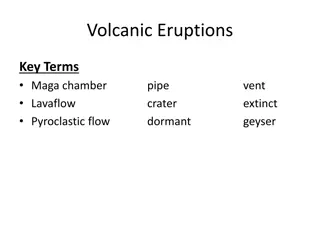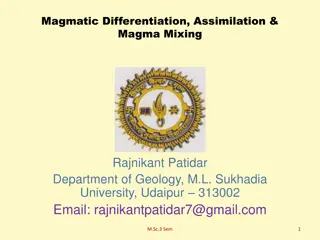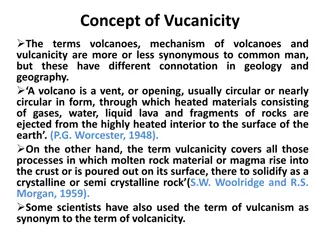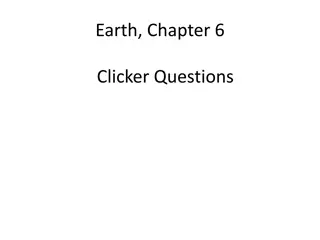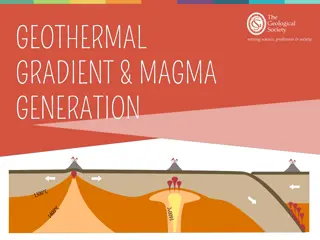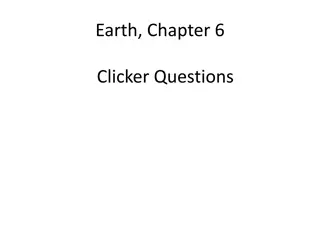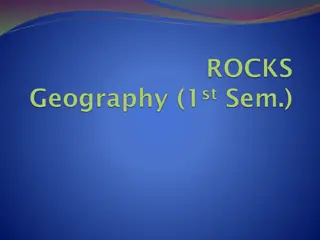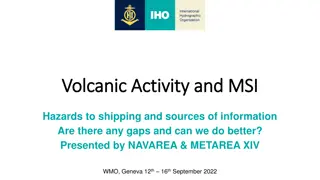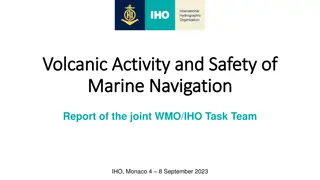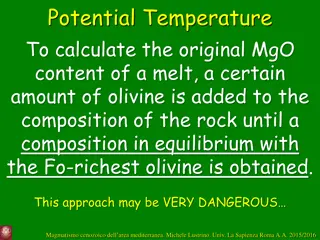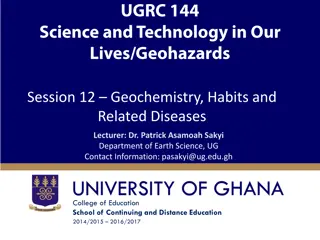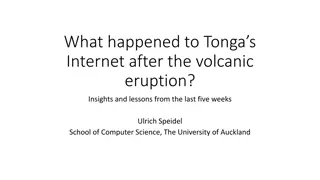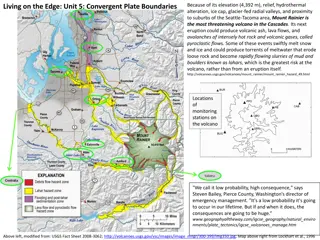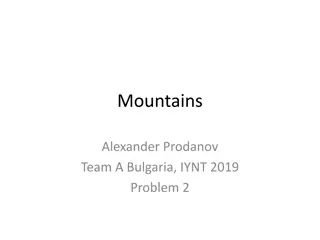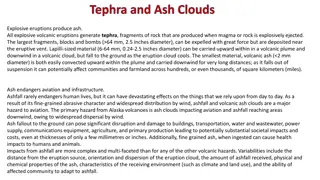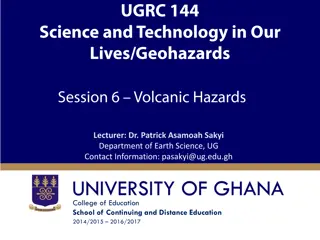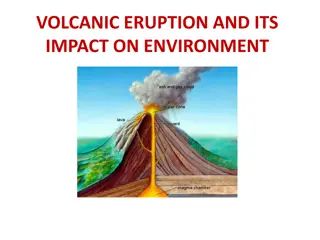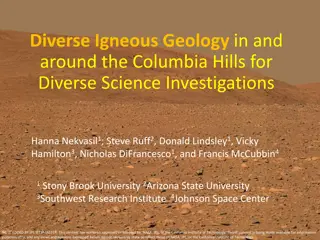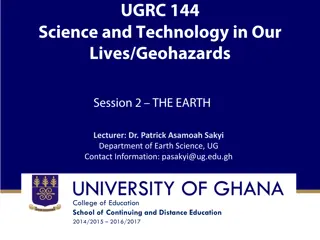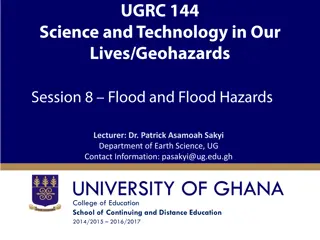Understanding Volcanic Processes and Magma Formation with Dr. Patrick Asamoah Sakyi
Explore the dynamics of volcanic eruptions, magma formation, and volcanic materials in this session led by Dr. Patrick Asamoah Sakyi from the Department of Earth Science at UG. Delve into topics such as magma origins, lava composition, factors influencing volcanic eruptions, volcano classification, and types of volcanoes. Gain insights into the sequence of events leading to volcanic activity and the forces driving volcanism. Recommended reading materials are provided to supplement your understanding of geology and environmental hazards.
Download Presentation

Please find below an Image/Link to download the presentation.
The content on the website is provided AS IS for your information and personal use only. It may not be sold, licensed, or shared on other websites without obtaining consent from the author. Download presentation by click this link. If you encounter any issues during the download, it is possible that the publisher has removed the file from their server.
E N D
Presentation Transcript
Lecturer: Dr. Patrick Asamoah Sakyi Department of Earth Science, UG Contact Information: pasakyi@ug.edu.gh College of Education School of Continuing and Distance Education 2014/2015 2016/2017
Session Overview This session introduces students to ; sequence of events that take place in order for volcanic eruption to occur. volcanic processes and the materials involved, driving forces of volcanism, the volcanic processes, environments where magma is formed prior to its ascent to the surface of the earth or to shallow levels. the composition of magma or lava and its effect on the degree of eruption and the type of volcano formed. Slide 2 Dr. Patrick A. Sakyi, Dept. of Earth Science
Session Outline The key topics to be covered in the session are as follows: Topic One Magma Formation Topic Two Lavas, Volcano and Volcanism Topic Three Volcanic Material Topic Four Factors Affecting Volcanic Eruptions Topic Five Classification of Volcanoes Topic Six - Types of Volcanoes Slide 3 Dr. Patrick A. Sakyi, Dept. of Earth Science
Reading List Chapter 5 of Environmental Geology 4th Edition by Carla W Montgomery (1995) Unit 1, Section 5 of UGRC 140 II Geohazards Institute of Continuing and Distance Education Slide 4 Dr. Patrick A. Sakyi, Dept. of Earth Science
Topic One MAGMA FORMATION Slide 5 Dr. Patrick A. Sakyi, Dept. of Earth Science
Magma Formation Partial melting of portions of the upper mantle and crust occurs to form hot, molten material in the interior of the Earth is called Magma. Magma is simply a melt, a liquid solution of elements at high temperature that forms deep in the Earth (50 - 200 kilometres or so) Once melt occurs, the magma tends to rise toward the surface of the earth and because it is less denser than solid rock. Slide 6 Dr. Patrick A. Sakyi, Dept. of Earth Science
Magma Formation As magma rises, cooling begins. With a decrease in temperature, the melt starts to solidify and mineral grains begin to grow. The heat required to generate magma comes from within the earth Slide 7 Dr. Patrick A. Sakyi, Dept. of Earth Science
Magma Formation As magma rises, it moves into harder, colder rock of the lithosphere, where it slows down and collects in larger bodies to form magma chambers which are network of interconnected channels As magma nears the surface, its dissolved gases begin to come out of solution. The combination of buoyancy and degassing is what powers volcanic eruptions Dr. Patrick A. Sakyi, Dept. of Earth Science Slide 8
Magma Formation - Role of Heat & Water Role of Heat The geothermal gradient - Earth s natural temperature increases with depth but is not sufficient to melt rock in the lower crust and upper mantle Additional heat is generated by; - friction in subduction zones - crustal rocks heated during subduction - rising, hot mantle rocks Slide 9 Dr. Patrick A. Sakyi, Dept. of Earth Science
Magma Formation - Role of Heat & Water Role of Water Causes rock to melt at a lower temperature Plays an important role in subducting ocean plates Slide 10 Dr. Patrick A. Sakyi, Dept. of Earth Science
Magma Formation Environment of Formation Environments include; - continental rift zones - subduction zones - mid-oceanic ridges - hotspots (mantle plumes) Slide 11 Dr. Patrick A. Sakyi, Dept. of Earth Science
Topic Two LAVA, VOLCANO AND VOLCANISM Slide 12 Dr. Patrick A. Sakyi, Dept. of Earth Science
Lavas, Volcano & Volcanism A volcano is essentially a fissure or vent communicating with the interior of the earth from which hot, molten rock (magma), rock fragments, ashes, dust and gases erupt Volcanoes erupt lavas with varying compositions depending on what part of their magma chambers they are tapping. The composition of a given magma also depends on the composition of the part of the mantle that is melted. Slide 13 Dr. Patrick A. Sakyi, Dept. of Earth Science
Lavas, Volcano & Volcanism Volcanism is the eruption of Lava from deep in the Earth. Volcanoes represent the surface expressions of subsurface igneous activity. The mountain or hill formed by the eruptive lava/debris is also often called a volcano. Slide 14 Dr. Patrick A. Sakyi, Dept. of Earth Science
Lavas, Volcano & Volcanism Anatomy of a Typical Volcano Slide 15 Dr. Patrick A. Sakyi, Dept. of Earth Science
Lavas, Volcano & Volcanism A crater is the depression at the summit of a volcano or that which is produced by a meteorite impact. A conduit, or pipe, carries gas-rich magma to the surface. A vent is an opening in the Earth's crust where molten lava and volcanic gases escape onto the land surface or into the atmosphere Slide 16 Dr. Patrick A. Sakyi, Dept. of Earth Science
Lavas, Volcano & Volcanism If magma is extruded onto the surface of the earth, it becomes a lava andforms Extrusive/Volcanic igneous rocks. Slide 17 Dr. Patrick A. Sakyi, Dept. of Earth Science
Topic Three VOLCANIC MATERIAL Slide 18 Dr. Patrick A. Sakyi, Dept. of Earth Science
Volcanic Material Three basic kinds of materials may erupt from a volcano. They are: - Lava - Rock Fragments and - Gas When lava comes to the surface, it is red hot and may have temperatures of more than 1,100oC. Slide 19 Dr. Patrick A. Sakyi, Dept. of Earth Science
Volcanic Material Lava Flows Basaltic lavas are more fluid Pillow lava contains characteristic pillow-shaped structures that are attributed to the extrusion of the lava under water, or subaqueous extrusion Aa lava (stony rough lava)- characterized by a rough or rubble surface composed of broken lava blocks. Pahoehoe Lava (smooth, unbroken lava) - has a smooth and undulating surface Slide 20 Dr. Patrick A. Sakyi, Dept. of Earth Science
Volcanic Material Highly fluid lava flows rapidly down a volcano s slopes. Viscous lava flows more slowly. Rock fragments, generally called tephra are formed from viscous magma. Tephra includes - volcanic dust, - volcanic ash and - volcanic bombs. Pyroclastic is the name given to particles produced in volcanic eruptions. Slide 21 Dr. Patrick A. Sakyi, Dept. of Earth Science
Volcanic Material Volcanic dust consists of particles 0.25 mm in diameter and can be carried great distances. Some scientists believe that large quantities of volcanic dust can affect the climate by reducing the amount of sunlight that reaches the earth. Volcanic Ash is made up of fragments less than 0.5 mm. Sometimes volcanic ash combines with water in a stream or lake and forms a boiling mudflow. Mudflows may rich speeds of 100 kilometres per hour and can be highly destructive. Slide 22 Dr. Patrick A. Sakyi, Dept. of Earth Science
Volcanic Material Volcanic bombs are large fragments. The largest ones may measure more than one metre across. Small volcanic bombs are generally called cinders. Gas pours out of volcanoes in large quantities during most eruptions. Volcanic gas carries a large amount of volcanic dust and this combination of gas and dust looks like black smoke. Slide 23 Dr. Patrick A. Sakyi, Dept. of Earth Science
Topic Four FACTORS AFFECTING VOLCANIC ERUPTIONS Slide 24 Dr. Patrick A. Sakyi, Dept. of Earth Science
Factors Affecting Volcanic Eruptions Factors that determine the violence of an eruption are; Composition of the magma Temperature of the magma Dissolved gases in the magma Slide 25 Dr. Patrick A. Sakyi, Dept. of Earth Science
Factors Affecting Volcanic Eruptions Viscosity of Magmas Viscosity describes a fluid s resistance to flow. Viscosity depends primarily on the composition of the magma and temperature. Factors affecting viscosity Temperature (hotter magmas are less viscous) Composition (silica content) Slide 26 Dr. Patrick A. Sakyi, Dept. of Earth Science
Factors Affecting Volcanic Eruptions Temperature Lower temperature magmas have higher viscosity than higher temperature magmas (viscosity increases with decreasing temperature of the magma). Composition (Silica Content) Viscosity increases with increasing SiO2 concentration in the magma). 1. High silica - high viscosity (e.g., rhyolitic lava) 2. Low silica low viscosity/more fluid (e.g., basaltic lava) Slide 27 Dr. Patrick A. Sakyi, Dept. of Earth Science
Factors Affecting Volcanic Eruptions Composition of Dissolved Gases in Magmas/Lavas Mostly H2O (water vapor) & some CO2 (carbon dioxide) Minor amounts of Sulfur (Hydrogen sulphide (H2S) & Sulphur dioxide (SO2)), Chlorine, and Fluorine gases Gases give magmas their explosive character, because volume of gas expands as pressure is reduced. Gases expand near the surface and provide the force to extrude lava. Slide 28 Dr. Patrick A. Sakyi, Dept. of Earth Science
Factors Affecting Volcanic Eruptions Composition of Dissolved Gases in Magmas/Lavas The amount of gas in a magma is also related to the chemical composition of the magma. Rhyolitic magmas usually have higher gas contents than basaltic magmas. Violence of an eruption is related to how easily gases escape from magma Gases escape easily from fluid magma Viscous magma produces a more violent eruption Slide 29 Dr. Patrick A. Sakyi, Dept. of Earth Science
Factors Affecting Volcanic Eruptions Slide 30 Dr. Patrick A. Sakyi, Dept. of Earth Science
Topic Five CLASSIFICATION OF VOLCANOES Slide 31 Dr. Patrick A. Sakyi, Dept. of Earth Science
Classification of Volcanoes Volcanoes have been classified according to their plate-tectonic settings. They are: Subduction-Zone Volcanoes: these occur along convergent plate boundaries Rift Volcanoes: occur along separating plate boundaries Hot-Spot Volcanoes: occur within plates. Slide 32 Dr. Patrick A. Sakyi, Dept. of Earth Science
Topic Six TYPES OF VOLCANOES Slide 33 Dr. Patrick A. Sakyi, Dept. of Earth Science
Types of Volcanoes Volcanoes can be classified by their shape and sizes; Shield Volcanoes Cinder Cones Calderas Stratovolcano (Composite Volcano) Lava Dome Slide 34 Dr. Patrick A. Sakyi, Dept. of Earth Science
Types of Volcanoes Shield Volcano is a large, gently sloping volcano characterized by broader dome Shield volcanoes are formed by lava flows of low viscosity-lava that flows easily Example is the Mauna Loa Shield Volcano, Hawaii. Slide 35 Dr. Patrick A. Sakyi, Dept. of Earth Science
Types of Volcanoes Cinder cone is small volcano with a steep conical hill of volcanic fragments that accumulate around and downwind from a volcanic vent. They are built primarily of pyroclastic (rock fragments) material ejected from a single vent. Cinder cones have a bowl- shaped crater at the summit Slide 36 Dr. Patrick A. Sakyi, Dept. of Earth Science
Types of Volcanoes Stratovolcanoes (Composite Volcanoes) are characterized by a steep profile and periodic, explosive eruptions. The lava that flows from stratovolcanoes tends to be viscous; it cools and hardens before spreading far. Slide 37 Dr. Patrick A. Sakyi, Dept. of Earth Science
Types of Volcanoes Caldera is usually a large circular depression at the summit of a volcano. It is usually formed by the collapse of land following a volcanic eruption. The collapse is triggered by the emptying of the magma chamber beneath the volcano, usually as the result of a large If enough magma is ejected, the emptied chamber is unable to support the weight of the volcanic Slide 38 structure above it Dr. Patrick A. Sakyi, Dept. of Earth Science volcanic eruption.
Types of Volcanoes Lava Dome is a roughly circular mound-shaped protrusion resulting from the slow eruption of felsic lava (usually rhyolite or dacite) from a volcano, or from multiple lava episodes of different magma types. The characteristic dome shape is attributed to high viscosity that prevents the lava from flowing very far. Slide 39 Dr. Patrick A. Sakyi, Dept. of Earth Science
Summary This session touched on the formation of magma and the roles played by heat and water. We also looked at the environment where magma forms. Mention was also made of the factors that affect volcanic eruptions and these include, temperature and composition, as well as the gas component of the magma/lava. Types of volcanoes and the anatomy of a volcano has were also discussed. Slide 40 Dr. Patrick A. Sakyi, Dept. of Earth Science
END Slide 41 Dr. Patrick A. Sakyi, Dept. of Earth Science
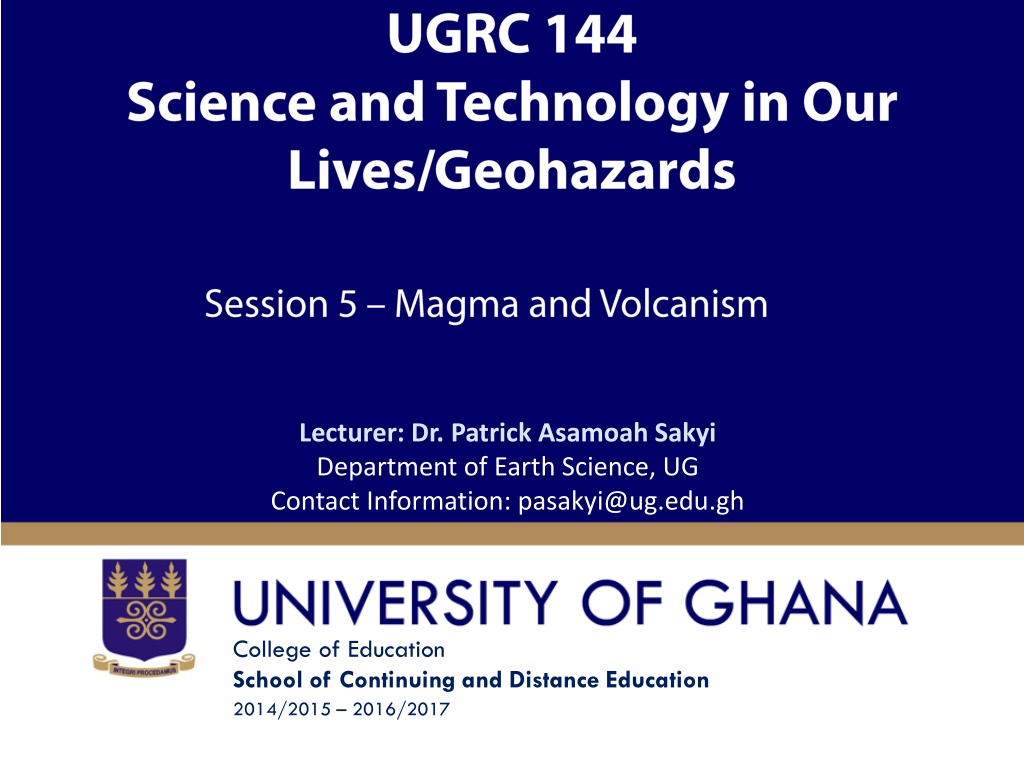

![Read⚡ebook✔[PDF] Io After Galileo: A New View of Jupiter's Volcanic Moon (Sprin](/thumb/21612/read-ebook-pdf-io-after-galileo-a-new-view-of-jupiter-s-volcanic-moon-sprin.jpg)
